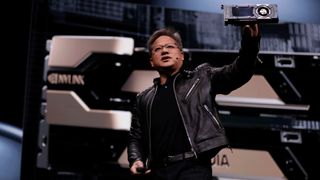Nvidia CEO says "we're not anywhere close" to meeting the demand for its GPUs
It's a combination of factors, including cryptocurrency, gaming, and supercomputing.

Nvidia CEO Jensen Huang has been busy this week with the company's annual GPU Technology Conference. But in a pre-GTC interview with TechCrunch, the bigger news for gamers is this statement. "The video supply chain is working really hard, and you know all of our partners are working around the clock. We’ve got to come closer to the demand of the market. And right now, we’re not anywhere near close to that and so we’re just going to have to keep running." In short, if you're hoping graphics card prices will return to 'normal' anytime soon, you might be in for some disappointment.
But the culprit here isn't just cryptocurrency miners, which Jensen claims represent only a small percent of Nvidia's total market share. Gamers are another big piece of the pie, certainly, and that's where Nvidia's roots lie. But look a bit further and it's clear that machine learning and AI research is undergoing a sea-change in technology. At the GTC keynote, for example, Jensen unveiled the updated DGX-2 server, which packs a whopping 2 PFLOPS of machine learning computational power into a 16 GPU box.
Priced at $399,000 per box, you might think demand would be low, but I suspect larger research groups are lining up to buy the box. That's not without precedent. The original DGX-1 server was announced two years ago at GTC, sporting the first Pascal processors and priced at $129,000 (with eight GPUs). The DGX-1 was backordered for about nine months after launch. With the substantially faster NVSwitch fabric boosting GPU-to-GPU communications, plus doubling down on the HBM2 memory, supercomputing will happily pay the price premium for the new DGX-2.
With the surge in demand from multiple vectors, not to mention less GDDR5 than AMD and Nvidia would like, GPUs are set to remain in short supply. Mining profitability has taken a significant hit of late, so at least demand from that sector should be dropping. Even so, while Jensen says he's "frustrated so many developers and gamers around the world cannot get access to their GeForces," it may be months (or more) before affordable consumer graphics cards are once again available.
The biggest gaming news, reviews and hardware deals
Keep up to date with the most important stories and the best deals, as picked by the PC Gamer team.
Jarred's love of computers dates back to the dark ages when his dad brought home a DOS 2.3 PC and he left his C-64 behind. He eventually built his first custom PC in 1990 with a 286 12MHz, only to discover it was already woefully outdated when Wing Commander was released a few months later. He holds a BS in Computer Science from Brigham Young University and has been working as a tech journalist since 2004, writing for AnandTech, Maximum PC, and PC Gamer. From the first S3 Virge '3D decelerators' to today's GPUs, Jarred keeps up with all the latest graphics trends and is the one to ask about game performance.
Most Popular






